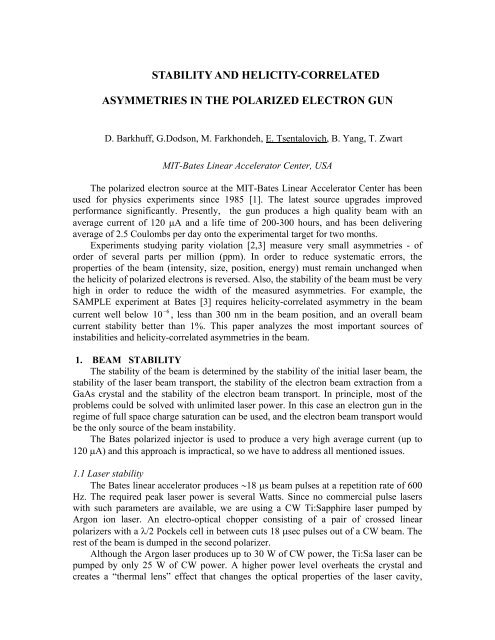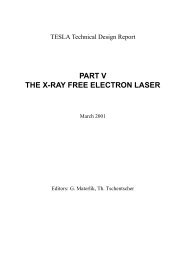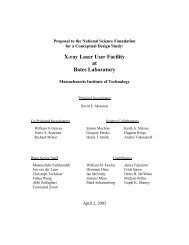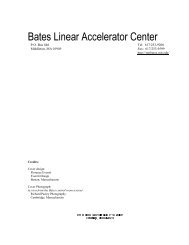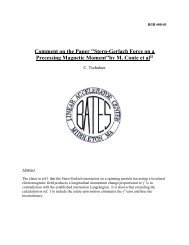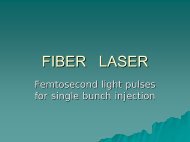Stability and helicity-correlated asymmetries in the polarized ... - MIT
Stability and helicity-correlated asymmetries in the polarized ... - MIT
Stability and helicity-correlated asymmetries in the polarized ... - MIT
Create successful ePaper yourself
Turn your PDF publications into a flip-book with our unique Google optimized e-Paper software.
STABILITY AND HELICITY-CORRELATED<br />
ASYMMETRIES IN THE POLARIZED ELECTRON GUN<br />
D. Barkhuff, G.Dodson, M. Farkhondeh, E. Tsentalovich, B. Yang, T. Zwart<br />
<strong>MIT</strong>-Bates L<strong>in</strong>ear Accelerator Center, USA<br />
The <strong>polarized</strong> electron source at <strong>the</strong> <strong>MIT</strong>-Bates L<strong>in</strong>ear Accelerator Center has been<br />
used for physics experiments s<strong>in</strong>ce 1985 [1]. The latest source upgrades improved<br />
performance significantly. Presently, <strong>the</strong> gun produces a high quality beam with an<br />
average current of 120 µA <strong>and</strong> a life time of 200-300 hours, <strong>and</strong> has been deliver<strong>in</strong>g<br />
average of 2.5 Coulombs per day onto <strong>the</strong> experimental target for two months.<br />
Experiments study<strong>in</strong>g parity violation [2,3] measure very small <strong>asymmetries</strong> - of<br />
order of several parts per million (ppm). In order to reduce systematic errors, <strong>the</strong><br />
properties of <strong>the</strong> beam (<strong>in</strong>tensity, size, position, energy) must rema<strong>in</strong> unchanged when<br />
<strong>the</strong> <strong>helicity</strong> of <strong>polarized</strong> electrons is reversed. Also, <strong>the</strong> stability of <strong>the</strong> beam must be very<br />
high <strong>in</strong> order to reduce <strong>the</strong> width of <strong>the</strong> measured <strong>asymmetries</strong>. For example, <strong>the</strong><br />
SAMPLE experiment at Bates [3] requires <strong>helicity</strong>-<strong>correlated</strong> asymmetry <strong>in</strong> <strong>the</strong> beam<br />
−6<br />
current well below 10 , less than 300 nm <strong>in</strong> <strong>the</strong> beam position, <strong>and</strong> an overall beam<br />
current stability better than 1%. This paper analyzes <strong>the</strong> most important sources of<br />
<strong>in</strong>stabilities <strong>and</strong> <strong>helicity</strong>-<strong>correlated</strong> <strong>asymmetries</strong> <strong>in</strong> <strong>the</strong> beam.<br />
1. BEAM STABILITY<br />
The stability of <strong>the</strong> beam is determ<strong>in</strong>ed by <strong>the</strong> stability of <strong>the</strong> <strong>in</strong>itial laser beam, <strong>the</strong><br />
stability of <strong>the</strong> laser beam transport, <strong>the</strong> stability of <strong>the</strong> electron beam extraction from a<br />
GaAs crystal <strong>and</strong> <strong>the</strong> stability of <strong>the</strong> electron beam transport. In pr<strong>in</strong>ciple, most of <strong>the</strong><br />
problems could be solved with unlimited laser power. In this case an electron gun <strong>in</strong> <strong>the</strong><br />
regime of full space charge saturation can be used, <strong>and</strong> <strong>the</strong> electron beam transport would<br />
be <strong>the</strong> only source of <strong>the</strong> beam <strong>in</strong>stability.<br />
The Bates <strong>polarized</strong> <strong>in</strong>jector is used to produce a very high average current (up to<br />
120 µA) <strong>and</strong> this approach is impractical, so we have to address all mentioned issues.<br />
1.1 Laser stability<br />
The Bates l<strong>in</strong>ear accelerator produces ∼18 µs beam pulses at a repetition rate of 600<br />
Hz. The required peak laser power is several Watts. S<strong>in</strong>ce no commercial pulse lasers<br />
with such parameters are available, we are us<strong>in</strong>g a CW Ti:Sapphire laser pumped by<br />
Argon ion laser. An electro-optical chopper consist<strong>in</strong>g of a pair of crossed l<strong>in</strong>ear<br />
polarizers with a λ/2 Pockels cell <strong>in</strong> between cuts 18 µsec pulses out of a CW beam. The<br />
rest of <strong>the</strong> beam is dumped <strong>in</strong> <strong>the</strong> second polarizer.<br />
Although <strong>the</strong> Argon laser produces up to 30 W of CW power, <strong>the</strong> Ti:Sa laser can be<br />
pumped by only 25 W of CW power. A higher power level overheats <strong>the</strong> crystal <strong>and</strong><br />
creates a “<strong>the</strong>rmal lens” effect that changes <strong>the</strong> optical properties of <strong>the</strong> laser cavity,
causes beam <strong>in</strong>stability, <strong>and</strong> affects <strong>the</strong> mode structure of <strong>the</strong> laser beam. In order to<br />
m<strong>in</strong>imize <strong>the</strong> heat load on <strong>the</strong> crystal, a mechanical chopper has been <strong>in</strong>stalled between<br />
<strong>the</strong> two lasers. The mechanical chopper is a rotat<strong>in</strong>g slotted wheel that cuts 250 µs pulses<br />
out of CW beam from <strong>the</strong> Ar laser. The wheel produces pulses at a repetition rate of 600<br />
Hz <strong>and</strong> is phase-locked with <strong>the</strong> pulses fir<strong>in</strong>g <strong>the</strong> electro-optical chopper. The mechanical<br />
chopper reduces <strong>the</strong> average power on <strong>the</strong> Ti:Sa crystal by a factor of 7, but keeps <strong>the</strong><br />
peak power <strong>in</strong>tact.<br />
Never<strong>the</strong>less, <strong>the</strong> stability of <strong>the</strong> laser <strong>in</strong> this “pulsed” mode with a peak pump power<br />
of 30 W is worse than <strong>in</strong> CW mode, <strong>in</strong> both <strong>in</strong>tensity <strong>and</strong> mode structure. Very careful<br />
tun<strong>in</strong>g is needed to achieve high output power with good <strong>in</strong>tensity stability <strong>and</strong> mode<br />
structure. The <strong>in</strong>tensity stability of <strong>the</strong> output beam is usually 1% or better.<br />
Electro-optical stabilizers are used to improve <strong>the</strong> stability fur<strong>the</strong>r. Commercially<br />
available stabilizers consist of a Pockels cell followed by a l<strong>in</strong>ear polarizer. A beam<br />
splitter after <strong>the</strong> polarizer splits a small fraction of <strong>the</strong> beam to a detector for<br />
measurements. A feedback circuit controls <strong>the</strong> voltage applied to <strong>the</strong> Pockels cell <strong>and</strong><br />
keeps <strong>the</strong> <strong>in</strong>tensity of <strong>the</strong> beam that passes through <strong>the</strong> polarizer constant. A drawback of<br />
<strong>the</strong>se systems is substantial <strong>in</strong>tensity loss (30% or more). We developed a stabilizer with<br />
very low loss (∼10%) us<strong>in</strong>g a bipolar 200 Volt amplifier with a ga<strong>in</strong> b<strong>and</strong>width of 100<br />
MHz. Ra<strong>the</strong>r than <strong>the</strong> light <strong>in</strong>tensity, <strong>the</strong> current of <strong>the</strong> extracted beam measured by a<br />
toroid is used as a control signal. This suppresses <strong>in</strong>stabilities <strong>in</strong> laser <strong>in</strong>tensity, extraction<br />
efficiency <strong>and</strong> <strong>the</strong> first stage of <strong>the</strong> electron beam transport comb<strong>in</strong>ed. The difference<br />
between <strong>the</strong> toroid’s signal <strong>and</strong> <strong>the</strong> preset level is amplified <strong>and</strong> applied to a Pockels cell.<br />
The stabilizer improves <strong>the</strong> stability by a factor of five. A stability of 0.2-0.5 % <strong>in</strong> <strong>the</strong><br />
electron beam current is rout<strong>in</strong>ely achieved at <strong>the</strong> end of <strong>the</strong> <strong>in</strong>jector.<br />
1.2 Laser beam transport <strong>and</strong> beam extraction<br />
The Quantum Efficiency (QE) of <strong>the</strong> crystal may vary across <strong>the</strong> crystal, especially if<br />
<strong>the</strong> crystal has been used for a long time. The QE may also depend on <strong>the</strong> density of <strong>the</strong><br />
current extracted (current saturation effect [4,5]). The first effect leads to a dependence of<br />
<strong>the</strong> <strong>in</strong>tensity of <strong>the</strong> extracted current on <strong>the</strong> beam position. The second one leads to a<br />
dependence on <strong>the</strong> beam size.<br />
The beam size variation can only be suppressed by a careful tun<strong>in</strong>g of <strong>the</strong> laser to a<br />
stable mode structure. In order to avoid beam position <strong>in</strong>stabilities on <strong>the</strong> crystal, a lens is<br />
placed <strong>in</strong> <strong>the</strong> middle of <strong>the</strong> path between <strong>the</strong> laser <strong>and</strong> <strong>the</strong> gun. (The total length of <strong>the</strong><br />
path is ∼20 m.) The lens produces a po<strong>in</strong>t-to-po<strong>in</strong>t focus<strong>in</strong>g between <strong>the</strong> laser <strong>and</strong> <strong>the</strong><br />
GaAs crystal, so angular variation of <strong>the</strong> laser beam does not produce position variation<br />
of <strong>the</strong> beam on <strong>the</strong> crystal.<br />
The entire laser transport path is enclosed <strong>in</strong> pipes to avoid air steer<strong>in</strong>g. The section<br />
of <strong>the</strong> pipe that leads from <strong>the</strong> laser room <strong>in</strong>to <strong>the</strong> accelerator vault below is sealed with<br />
flat w<strong>in</strong>dows at both ends to suppress a chimney effect.<br />
The properties of <strong>the</strong> w<strong>in</strong>dow through which <strong>the</strong> laser beam enters <strong>the</strong> vacuum<br />
chamber may affect <strong>the</strong> laser beam stability. The old version of <strong>the</strong> w<strong>in</strong>dow was equipped<br />
with a high-quality flat glass without a wedge. The “normal” reflectivity of <strong>the</strong> glass is<br />
8%. If <strong>the</strong> wavelength of <strong>the</strong> laser beam matches <strong>the</strong> w<strong>in</strong>dow thickness, <strong>the</strong> beams<br />
reflected from <strong>the</strong> front <strong>and</strong> back surfaces of <strong>the</strong> w<strong>in</strong>dow <strong>in</strong>terfere <strong>and</strong> <strong>the</strong> reflectivity<br />
−4<br />
may be very close to zero. Our laser system has a wide b<strong>and</strong>width ∆ω/ω∼10 <strong>and</strong> <strong>the</strong>
wavelength of <strong>the</strong> laser light is unstable <strong>in</strong> this range with a characteristic time of few<br />
seconds. The phase advance between <strong>the</strong> light reflected from <strong>the</strong> front <strong>and</strong> from <strong>the</strong> back<br />
surface of <strong>the</strong> w<strong>in</strong>dow ∆ϕ=2π(∆ω/ω)(2d/λ) (d=4mm is a thickness of <strong>the</strong> w<strong>in</strong>dow) varies<br />
from 0 to 2π, <strong>and</strong> <strong>the</strong> reflectivity of <strong>the</strong> w<strong>in</strong>dow changes from 8 to 0%. The problem was<br />
solved by <strong>in</strong>stall<strong>in</strong>g a slightly wedged glass <strong>in</strong> <strong>the</strong> w<strong>in</strong>dow.<br />
1.3 Electron beam transport<br />
The electron beam passes through <strong>the</strong> chopper at <strong>the</strong> entrance of <strong>the</strong> accelerator. The<br />
capture efficiency is 30-40% <strong>and</strong> strongly depends on <strong>the</strong> beam position on <strong>the</strong> chopper<br />
collimator. Therefore, beam position variation results <strong>in</strong> <strong>in</strong>tensity <strong>in</strong>stability of <strong>the</strong> beam.<br />
In <strong>the</strong> area <strong>in</strong> <strong>and</strong> immediately after <strong>the</strong> gun <strong>the</strong> beam energy is low, <strong>and</strong> <strong>the</strong> beam is<br />
especially vulnerable to <strong>the</strong> <strong>in</strong>fluence of external magnetic fields. In order to protect <strong>the</strong><br />
beam from dc magnetic fields <strong>the</strong> beam l<strong>in</strong>e is wrapped with sheets of µ-metal. All ion<br />
pumps <strong>in</strong> vic<strong>in</strong>ity of <strong>the</strong> beam l<strong>in</strong>e are equipped with soft iron shields. The residual<br />
magnetic field <strong>in</strong> <strong>the</strong> beam area is less than 1 Gauss.<br />
Any equipment <strong>in</strong> <strong>the</strong> vic<strong>in</strong>ity of <strong>the</strong> gun may produce an electromagnetic field at a<br />
frequency of 60 Hz, so all power supply transformers, <strong>the</strong> ma<strong>in</strong> sources of this field, are<br />
covered with soft iron shields. A major source of 60 Hz field was a separate isolation<br />
transformer which supplies <strong>the</strong> gun equipment with ac power. The transformer produced<br />
a field of few tens of mGs <strong>in</strong>side <strong>the</strong> gun chamber <strong>and</strong> <strong>in</strong> <strong>the</strong> beam l<strong>in</strong>e. This ac field was<br />
sufficient to move <strong>the</strong> beam as much as 2-3 mm at <strong>the</strong> end of <strong>the</strong> beam l<strong>in</strong>e. The problem<br />
was significantly reduced by mov<strong>in</strong>g <strong>the</strong> transformer about 6 m away from <strong>the</strong> gun.<br />
The stability of all steer<strong>in</strong>g elements <strong>in</strong> <strong>the</strong> beam l<strong>in</strong>e has been analyzed <strong>and</strong> only<br />
power supplies that meet <strong>the</strong>se stability requirements are used. The controll<strong>in</strong>g<br />
electronics is <strong>in</strong>stalled <strong>in</strong>side screened cab<strong>in</strong>ets to suppress <strong>in</strong>terference from external<br />
radio-frequency signals.<br />
Any <strong>in</strong>sulator <strong>in</strong>side <strong>the</strong> beam l<strong>in</strong>e exposed to <strong>the</strong> beam may be a source of<br />
<strong>in</strong>stabilities. A stream of scattered electrons could charge <strong>the</strong> <strong>in</strong>sulators up to a voltage<br />
that is sufficient to steer <strong>the</strong> beam. When <strong>the</strong> charge on <strong>the</strong> <strong>in</strong>sulator reaches a critical<br />
value a discharge occurs, <strong>and</strong> <strong>the</strong> beam position changes <strong>in</strong>stantaneously. To avoid this<br />
effect, all <strong>in</strong>sulators must be hidden from <strong>the</strong> beam beh<strong>in</strong>d metal screens.<br />
2. HELICITY-CORRELATED ASYMMETRIES<br />
A <strong>helicity</strong>-<strong>correlated</strong> <strong>in</strong>tensity asymmetry orig<strong>in</strong>ates <strong>in</strong> an imperfect symmetry of <strong>the</strong><br />
laser transport system. Circularly <strong>polarized</strong> light with left (right) <strong>helicity</strong> is produced by<br />
apply<strong>in</strong>g a positive (negative) voltage to a λ/4 <strong>helicity</strong> Pockels cell (HPC). S<strong>in</strong>ce a small<br />
fraction of l<strong>in</strong>early <strong>polarized</strong> light always rema<strong>in</strong>s <strong>in</strong> <strong>the</strong> beam, any asymmetry for S <strong>and</strong><br />
P reflection <strong>in</strong> <strong>the</strong> laser transport system leads to a <strong>helicity</strong>-<strong>correlated</strong> asymmetry <strong>in</strong> <strong>the</strong><br />
beam <strong>in</strong>tensity.<br />
A transport system conta<strong>in</strong><strong>in</strong>g reflect<strong>in</strong>g mirrors or prisms may produce a <strong>helicity</strong><strong>correlated</strong><br />
positional asymmetry as well. We believe that <strong>the</strong> effect orig<strong>in</strong>ates <strong>in</strong> different<br />
distributions of <strong>the</strong> l<strong>in</strong>ear polarization fraction <strong>in</strong> <strong>the</strong> beam profile for <strong>the</strong> left <strong>and</strong> right<br />
helicities, comb<strong>in</strong>ed with an imperfect symmetry of <strong>the</strong> transport system. (We thank
Douglas Beck for <strong>the</strong> suggested explanation.) The effect may produce a positional<br />
difference as large as several microns. The HPC itself could produce an angular<br />
asymmetry for <strong>the</strong> left <strong>and</strong> right helicities due to a piezo effect.<br />
In order to suppress <strong>the</strong>se <strong>asymmetries</strong> <strong>the</strong> HPC was placed at <strong>the</strong> end of <strong>the</strong> laser<br />
transport l<strong>in</strong>e, after <strong>the</strong> last reflect<strong>in</strong>g mirror. This step virtually elim<strong>in</strong>ated <strong>the</strong> positional<br />
asymmetry associated with <strong>the</strong> transport l<strong>in</strong>e, <strong>and</strong> careful tun<strong>in</strong>g of <strong>the</strong> HPC reduces <strong>the</strong><br />
HPC-<strong>in</strong>duced asymmetry to well below 300 nm.<br />
A correction Pockels cell (CPC) is used to control <strong>the</strong> rema<strong>in</strong><strong>in</strong>g <strong>in</strong>tensity<br />
asymmetry. A λ/10 wave plate <strong>in</strong>stalled <strong>in</strong> front of <strong>the</strong> CPC produces a small fraction of<br />
circular polarization <strong>in</strong> <strong>the</strong> laser beam. In this configuration a small voltage applied to <strong>the</strong><br />
CPC changes <strong>the</strong> fraction of <strong>the</strong> beam pass<strong>in</strong>g through <strong>the</strong> polarizer after <strong>the</strong> CPC. The<br />
CPC power supply produces negative pulses for one <strong>helicity</strong> <strong>and</strong> positive pulses for<br />
ano<strong>the</strong>r <strong>in</strong> order to equalize <strong>the</strong>ir <strong>in</strong>tensities. The power supply is controlled by a slow<br />
feedback system that measures <strong>the</strong> <strong>helicity</strong>-<strong>correlated</strong> <strong>in</strong>tensity difference of <strong>the</strong> electron<br />
beam at <strong>the</strong> end of <strong>the</strong> accelerator. Although <strong>the</strong> accuracy of <strong>the</strong>se measurements is<br />
several ppm <strong>in</strong> a half-hour run, <strong>the</strong> <strong>in</strong>tensity difference averaged over 1-2 days run is<br />
−6<br />
usually below 10 . The angle of rotation of <strong>the</strong> λ/10 wave plate def<strong>in</strong>es <strong>the</strong> sensitivity of<br />
<strong>the</strong> beam <strong>in</strong>tensity to <strong>the</strong> CPC voltage, <strong>and</strong> we set it to about 50 ppm/Volt. This method<br />
allows <strong>the</strong> control of <strong>the</strong> <strong>helicity</strong>-<strong>correlated</strong> <strong>in</strong>tensity of <strong>the</strong> beam with a very small<br />
differential voltage on <strong>the</strong> Pockels cell, <strong>and</strong> <strong>the</strong> positional asymmetry produced <strong>in</strong> <strong>the</strong><br />
CPC due to piezo effect is vanish<strong>in</strong>gly small.<br />
In order to suppress a residual positional asymmetry <strong>the</strong> SAMPLE collaboration<br />
developed a correction device. It <strong>in</strong>cludes a piezo-driven optical flat. The angle of <strong>the</strong> flat<br />
relative to a laser beam can be controlled <strong>in</strong> a <strong>helicity</strong>-<strong>correlated</strong> way with a very high<br />
frequency (several kHz) <strong>and</strong> a <strong>helicity</strong>-<strong>correlated</strong> laser beam shift of up to 1 µm <strong>in</strong> any<br />
direction can be produced. This controlled shift compensates <strong>the</strong> residual positional<br />
asymmetry. Prelim<strong>in</strong>ary results <strong>in</strong>dicate that with <strong>the</strong> device positional <strong>asymmetries</strong><br />
averaged over 24 hour run are reduced from ≈200 nm to ≈50 nm.<br />
Summary: with implementation of improvements discussed <strong>in</strong> this paper, exceptional<br />
quality <strong>and</strong> stability of <strong>the</strong> beam have been achieved. The beam parameters meet or<br />
exceed <strong>the</strong> dem<strong>and</strong><strong>in</strong>g specifications of <strong>the</strong> SAMPLE experiment. To date, more than 80<br />
Coulombs have been delivered to <strong>the</strong> SAMPLE target <strong>and</strong> <strong>the</strong> experiment is nearly<br />
f<strong>in</strong>ished.<br />
References<br />
[1] G.D.Cates et al, NIM A 278, 293 (1989).<br />
[2] P.A.Soulder et al, Phys. Rev. C 65, 694 (1990).<br />
[3] B.Mueller et al, Phys. Rev. Lett. 78, 3824(1997).<br />
[4] M.Farkhondeh et al, Proc. of 7th Intern. Workshop on Polarized Gas Targets <strong>and</strong><br />
Polarized Beams, Urbana, IL, August 1993, AIP 421, p.240.<br />
[5] A.S.Jaroshevich et al, Proc. of 7th Intern. Workshop on Polarized Gas Targets <strong>and</strong><br />
Polarized Beams, Urbana, IL, August 1993, AIP 421, p.485.


